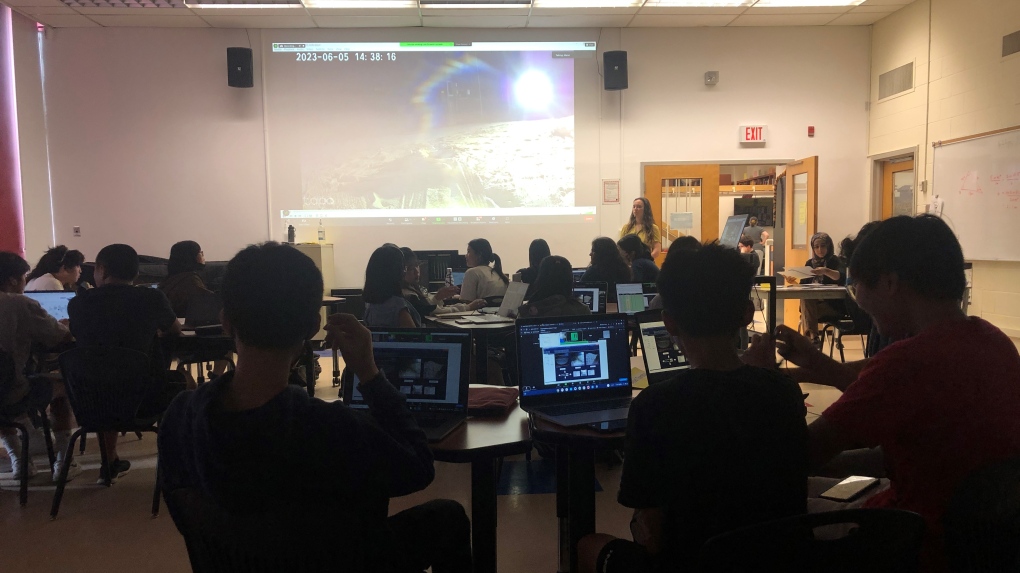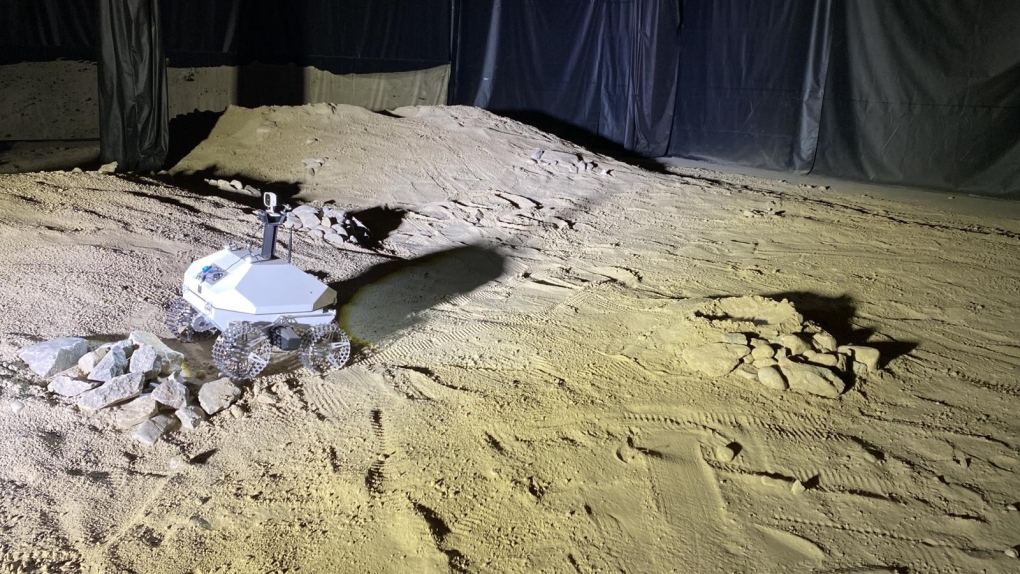Toronto students drive Canadian lunar rover prototype headed for moon exploration
Students from three Greater Toronto Area schools won a national competition to experience what it’s like to remotely control a lunar rover.
“I never knew anything about space or lunar rovers before so it was really fun to know that I won this competition,” Manvi Lakhani, a Grade 9 student at Bayview Secondary School in Richmond Hill, told CTV News Toronto Monday.
“I think the coolest part is that you’re literally on the moon, virtually, and you’re driving a rover on the moon without being there,” she said after taking control of the rover’s movements.
Lakhani was one of a handful students who won the Lunar Rover Research Challenge from education charity Let’s Talk Science after dozens of submissions from across the country. Students from Fallingbrook Middle School and Bristol Road Middle School in Mississauga were also chosen.
The students were given a mission — to use the rover to find ice on the moon. The drivers’ classmates were their support staff. Their job was to figure out which direction to take the rover, track battery life and temperature, and identify the right type of rocks to locate the ice. The first task was finding where the lunar rover had been dropped.
“We took 20 minutes to find it,” said navigator team member and Grade 9 student Tim Liu with a laugh.
“We used our orbital photos. We probably should have turned {the rover} first to see our surroundings, and we used one of our valuable resources to do it. After a while we figured it out.”
 Students from the Greater Toronto Area test out a lunar rover prototype headed for moon exploration. (Beth Macdonell)
Students from the Greater Toronto Area test out a lunar rover prototype headed for moon exploration. (Beth Macdonell)
The current lunar rover is located in a Stratford, Ontario, but the look of the terrain, the feel of the machine, and its challenges are similar to what operators will encounter on the moon.
Moving the rover takes a lot of time and work, said Leah Davis-Purcell, who was leading the simulation and is a technical systems and outreach worker with start-up Avalon Space.
“A two-hour session brings like 50 metres travel or way less than that, because there is so much conversation, thinking and consideration that goes into every move,” she explained.
In a few years, a possible version of the same lunar rover, which is being developed by Canadian engineers Canadensys Aerospace, will be part of the Artemis space missions to the moon. This version could be in action as early as 2026.
“I feel like I’m helping somehow. It feels like I’m making some kind of impact towards the future,” said Cassie Pang, who is in Grade 9 and was a member of the scientists team.
“I’m really happy because I’ll be part of history, slightly,” said Brian Xue, also with the scientists team. “I can say I helped scientists get to the moon.”
 A lunar rover prototype is seen in this undated photograph. (Photo courtesy of Canadensys Aerospace)
A lunar rover prototype is seen in this undated photograph. (Photo courtesy of Canadensys Aerospace)
About halfway through the simulation, the students at Bayview Secondary School were successful and located the ice on the moon.
The project is made possible through funding by the Canadian Space Agency.
CTVNews.ca Top Stories

BREAKING Trump picks former congressman Pete Hoekstra to be ambassador to Canada
U.S. president-elect Donald Trump has nominated former diplomat and U.S. congressman Pete Hoekstra to be the American ambassador to Canada.
Genetic evidence backs up COVID-19 origin theory that pandemic started in seafood market
A group of researchers say they have more evidence to suggest the COVID-19 pandemic started in a Chinese seafood market where it spread from infected animals to humans. The evidence is laid out in a recent study published in Cell, a scientific journal, nearly five years after the first known COVID-19 outbreak.
This is how much money you need to make to buy a house in Canada's largest cities
The average salary needed to buy a home keeps inching down in cities across Canada, according to the latest data.
'My two daughters were sleeping': London Ont. family in shock after their home riddled with gunfire
A London father and son they’re shocked and confused after their home was riddled with bullets while young children were sleeping inside.
Smuggler arrested with 300 tarantulas strapped to his body
Police in Peru have arrested a man caught trying to leave the country with 320 tarantulas, 110 centipedes and nine bullet ants strapped to his body.
Boissonnault out of cabinet to 'focus on clearing the allegations,' Trudeau announces
Prime Minister Justin Trudeau has announced embattled minister Randy Boissonnault is out of cabinet.
Baby dies after being reported missing in midtown Toronto: police
A four-month-old baby is dead after what Toronto police are calling a “suspicious incident” at a Toronto Community Housing building in the city’s midtown area on Wednesday afternoon.
Sask. woman who refused to provide breath sample did not break the law, court finds
A Saskatchewan woman who refused to provide a breath sample after being stopped by police in Regina did not break the law – as the officer's request was deemed not lawful given the circumstances.
Parole board reverses decision and will allow families of Paul Bernardo's victims to attend upcoming parole hearing in person
The families of the victims of Paul Bernardo will be allowed to attend the serial killer’s upcoming parole hearing in person, the Parole Board of Canada (PBC) says.


































